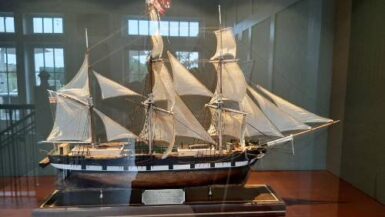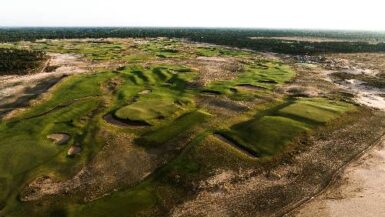
JOHNS CREEK, GA – Ron Whitten’s recent Golf Digest article on the new turfgrasses being tested this week at Atlanta Athletic Club’s PGA Championship is another excellent observation by one of the most intelligent voices in the game. His knowledge of architecture and travel is unparalleled. In his article he mentions a number of southern and western courses that should enter the discussion for hosting major championships now that healthy turf will become less of an issue. As a contrast, I wish to humbly offer some thoughts on his suggestions for future southern and western major championship venues, and also highlight a few of my favorites for all you intrepid golf travelers to go and visit.
While I love playing golf in the summer in Texas and Arizona, most people do not. Heat frequently surpasses three digits, and that’s a dangerous risk for heat stroke and heat poisoning. I was sick for three weeks after walking PGA West’s Stadium Course in 105 degree heat despite drinking a tall glass of ice water every hole. The health of spectators and players must be a paramount concern. People routinely drop like flies at Southern Hills, for example, so it’s not only the turfgrass that’s at issue for hosting a major out there, but the health and safety of the players and patrons as well. If major visits those states, start hydrating a year in advance.
Ron’s suggestion of Whisper Rock near Scottsdale is intriguing. For those of you scoring at home, several tour pros and many outstanding amateur golfers call Whisper Rock home. It’s got plenty of room for the infrastructure needed for a major, and it’s a stiff test by any standards. That could be a good choice. However, while I love playing Talking Stick (North), I’m not sure that course tough enough to challenge the pros for a major, though it would be supercool to see some professional tournament there. Even so, the summer heat will be suffocating, 95 and higher.
As an aside, my favorite of the southwestern U.S. courses is Black Mesa, a mesmerizing bucking bronco of a Baxter Spann design near Santa Fe, New Mexico. With its wild, undulating fairways and greens and a few blind shots, that course would have the pros crying like Nancy Kerrigan. Run don’t walk to go play that one.

In Texas, the designs at Champions Club and Dallas Athletic Club leave me unimpressed, as does anything near Houston. To me, the best choice in Texas is still Colonial, and if Torrey can draw a U.S. Open and Quail Ridge can get a PGA Championship, there is no excuse for not visiting Colonial for a PGA Championship, despite its hosting its PGA Tour event in May.
By the way, if we’re going to discuss courses that can host a PGA Tour event and a major in the same year, I have two words for you: “Hello?…Riviera!” If that fails, what about Monterey Peninsula Country Club’s Shore Course?
Apologies to Ron, but I absolutely loathe the suggestions of Innisbrook Copperhead and PGA National in Florida. I find them both boring, flavorless slogs. To me, the best courses in Florida are Sawgrass and Seminole, with World Woods and the newly redesigned Country Club of Florida close behind, though only Sawgrass can stage a big tournament. World Woods (Pine Barrens course) may be the most interesting course Tom Fazio has ever designed. That’s another one to put right at the top of your “Must Visit Now” list.
As for Arkansas, Alabama, or Lousiana, I have yet to see or read about a course which I find interesting enough to support as a choice for a major venue. However, no less a personage than Pete Dye himself, one of the two greatest living architects today, disagrees.
“Country Club of Birmingham would be a good choice,” he said in a recent conversation, referring to the old Donald Ross design in Alabama. “I’d also like to see them visit Indianapolis or St. Louis. Those people love golf like they do in Minnesota! They’d get a huge turnout.” When pressed for an Indiana venue, Dye immediately thought of Brickyard Crossing, his design which features four holes actually inside the Speedway oval. Fans couldn’t see much from the bleachers, but the spectator mounding on the four holes inside the track would provide a unique and surreal experience, both for the patrons and the television viewers. As for St. Louis, Dye will get his wish when the PGA Championship is held there in 2018.
Nevertheless, one mantra needs to shine more brightly than any other consideration: At a major championship, the course should be the star, like at Pebble Beach, Oakmont, Winged Foot, Oakland Hills and Shinnecock. Yes, they have enough room to hold the infrastructure necessary to stage the event, but the main reason they have so many majors on their resumes is that the golf architecture is the best in America.
As such, bite the bullet and bring an event to National Golf Links of America, Cypress Point, or Pine Valley. The World needs to see them up close to truly appreciate their genius. Indeed, that may be the overriding reason why the U.S.G.A. is throwing caution – and seemingly everything else – to the wind and returning to tiny, but storied Merion in 2013. The smallest and most landlocked of any major venue in decades, Merion will be so much of a logistical nightmare, the hot mess that was Congressional will look reasonable by comparison.
Speaking of infrastructures, if they can ever build the infrastructures to hold a big event, golf fans deserve to see the brilliant, indeed sublime designs in Nebraska and Colorado sand hills region. Tom Doak – the incendiary genius behind Pacific Dunes, Ballyneal, and Old Macdonald – is building a second course at Dismal River, and while it may not be a major venue, it will be a major success and an instant classic. At some time, either the PGA of America or the U.S.G.A. should forget about whatever the winning score might be and bring a major to one of those venues so the world can revel in America’s proper rejoinder to the great seaside links of the U.K.
Finally, I want to introduce everyone to a hidden gem of an Alister Mackenzie and Perry Maxwell masterpiece called Oklahoma City Golf and Country Club, a course I like even more than Southern Hills and which hosted the 1953 U.S. Amateur. All fans of Mackenzie and Maxwell should put this course at the top of their wish list. This brilliant, clever, and enchanting design should be put in the mix for some big tournaments immediately. It’s tough to beat Mackenzie and Maxwell for architecture.
Whitten is right: the advent of the new turfgrasses will open the door for new (and old) southern and western venues to host majors, but great gold course design must be one of the premiere considerations in the choice. Putting a course on television is a great way to introduce it to the World, so take the opportunity to reach as high as possible.




